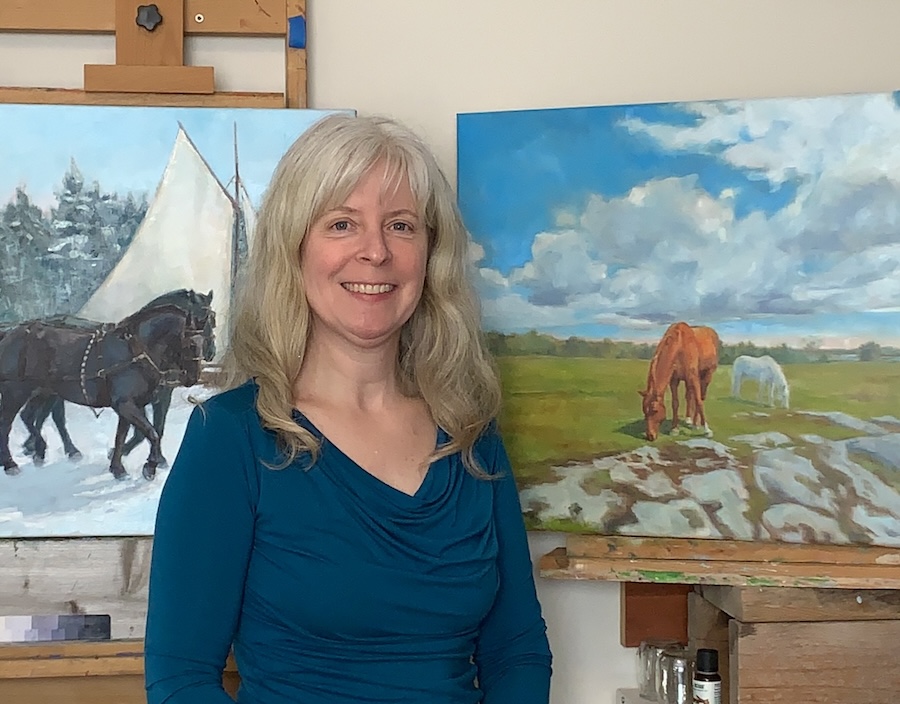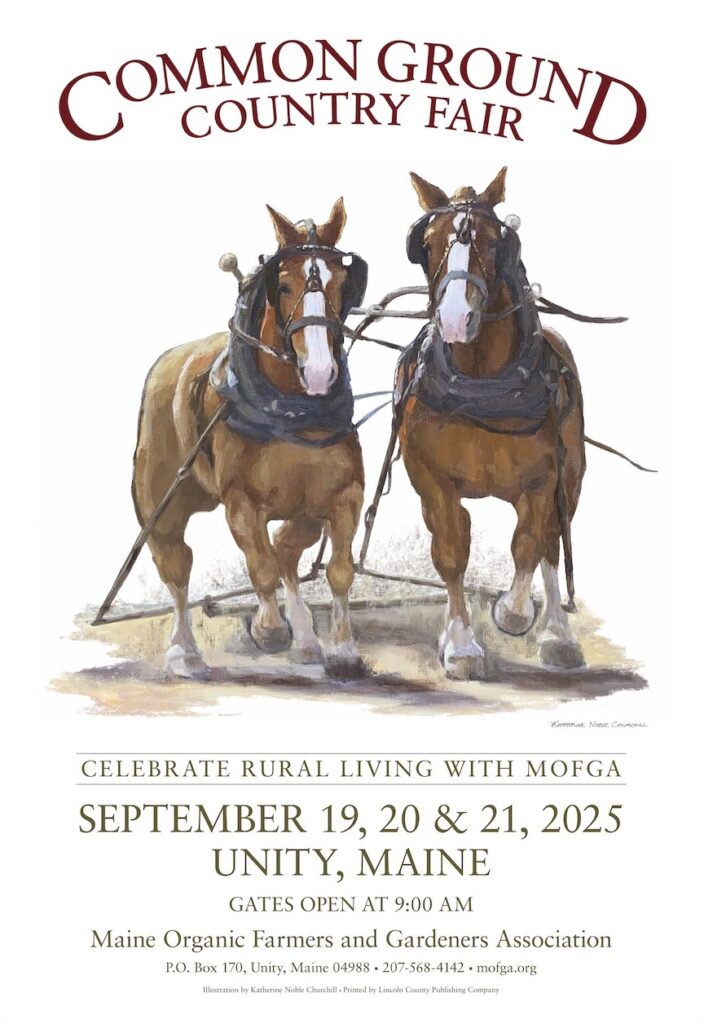By Holli Cederholm
For painter Katherine Noble Churchill, riding horses is part of the artistic process. While her work is categorized as impressionistic realism — and therefore true to life — Churchill does not paint portraits. “I like to paint things that are moving quite a bit,” she says. A wave washing over a seal, a heron hunting in a pond, or, in the case of her award-winning design for the 2025 Common Ground Country Fair poster contest, a team of draft horses pulling a load.

Artist Katherine Noble Churchill finds inspiration in the natural world, especially horses. Photo by the artist
To capture movement in a natural way, Churchill is constantly learning: about both her craft as an artist and the subjects she is inspired to paint. When she sits at an easel in her 12-by-14-foot in-home studio in Bar Harbor, Maine, Churchill conjures up “the story” of what she is trying to translate onto canvas, which often involves an animal or a landscape. Working from a photograph, she can recall the details of a specific scene that cannot be captured by camera — such as the play of a sea breeze on a gull’s feathers or the feeling of companionship between horses and humans. The camera, she says, will always flatten the light and change the shadows in a way that is untrue. Churchill uses the photos she takes for reference and fills in the gaps with research. In addition to studying the qualities of the landscape — such as how the sky can be reflected in a body of water — Churchill reads up on her subjects. For instance, she learned that a moose can stand in water for hours on end, foraging for aquatic plants, and that a tiny puffin catches up to 20 small fish at a time, carrying them to a nest in its oversized beak.
When it comes to horses, Churchill’s most frequent muse, she has decades of study under her belt. Churchill got her first pony when she was 11, and participated in pony club and eventing, including dressage, cross-country, and stadium jumping, in and around her home town of Dover-Foxcroft, Maine. She also tagged along with local large animal veterinarians on farm visits. When it came time to go to college, Churchill brought her horse, joining the equestrian team at the University of Massachusetts. They later moved to Orono, Maine, where the horse was boarded and Churchill earned a degree in pre-veterinary science from the University of Maine.
Though she took drawing classes as electives, Churchill didn’t pick up a brush with the intention of becoming a professional artist until about 15 years ago. After completing her degree, Churchill worked as a veterinary assistant and then a stay-at-home parent. She considered careers in farming and hospitality, but nothing inspired her quite like painting — which she says feeds her desire to always be learning something new.
Following a class she took at a community art center in North Carolina, Churchill committed to honing her skills: enrolling in workshops, reading about technique, transcribing other painters’ work, and joining an art critique group. She started working with a mentor, painter and gallery owner David Lussier, in 2020, and she spends a week each summer with him and his wife, Pam, on Monhegan Island. Here she engages in “plein air,” the practice of painting outdoors in an attempt to capture the scene unfiltered by camera or memory. Churchill says this approach helps to train her eyes to natural light and colors, and also loosens her brush strokes — as she has to paint faster. Back in her studio, she may work on a larger painting for months, rotating between it and several smaller works, adding detail stroke by careful stroke.

She credits her study of veterinary science in helping her better understand her animal subjects, including their bone and muscle structure and movement patterns. Her continued drive to improve her horsemanship also helps. After 20 years without a horse, Churchill started riding again a few years ago and recently purchased a 19-year-old chestnut German Holsteiner named Cordy from a friend. Her relationship to horses gives Churchill an increased understanding of them as painting subjects: their behavior, their gait, how they shift their weight, what they like and dislike. With this level of familiarity, she can accurately depict the shadow under a hoof or a muscle rippling as it fires to pull a farm implement.
It’s no surprise then that Churchill’s winning entry to MOFGA’s annual contest for the Common Ground Country Fair poster for 2025 features equines. Titled “Belgian Draft Horses,” the poster design is based on a team of working horses that the artist first photographed at the Blue Hill Fair a decade ago. Since that late-summer day, Churchill has painted the pair several times, in harness and without, and with the teamsters and the fairgrounds in the background. As with any painting, Churchill first sketched the composition of the piece on linen-stretched canvas before applying oil paint in layers, sometimes with brushes and sometimes with a palette knife. For this piece, she worked in the complimentary colors of blue and orange, using her brushes to create interesting edges — paying attention to lifelike detail.
She entered the Belgians into the Fair poster contest twice before they were selected as the winner. For her 2025 submission, Churchill thought more about what would look good on a T-shirt, versus framed on a gallery wall, and decided to erase the busy background of the Blue Hill Fair. She wanted to “isolate the draft horses and the dirt kicking up under them” to evoke the sense that they could be plowing or working in a field, rather than being exhibited. To do this, she took a photograph of her original painting and uploaded it into the art program Procreate to digitally remove the background. The final rendering softened the textures on the canvas, making the work look like it had been painted in watercolor.
“I was very excited when I got the call this year that they were accepted,” says Churchill.
Churchill has been attending the Common Ground Country Fair for over two decades and relates to people who work directly with the land and animals. Highlights of the Fair for her include visiting the livestock area, especially the bunny barn, fiber animals, and the horse demonstrations. At last year’s event, she photographed a mule team as well as a pair of sleek black horses pulling a carriage — both will be featured in future paintings. “I hope the animals’ personality comes through,” she says of her work.
To see more of Churchill’s artwork, including available paintings, or to request a commission, visit her website at katherinenoblechurchill.com.
This article was originally published in the summer 2025 issue of The Maine Organic Farmer & Gardener.